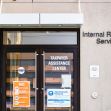At a news conference on the steps of the federal courthouse in Central Islip on Wednesday, December 2, Seth DuCharme, acting United States Attorney in Brooklyn, announced the indictment of six individuals in connection with a “birth tourism” scheme in Long Island, New York. DuCharme stated, “the indictment unsealed today reinforces the principle that American citizenship is not for sale, and that our benefits programs are not piggy banks for criminals to plunder.”
In three years from 2017 to 2020, at least 117 expectant Turkish mothers came to Suffolk County on tourist visas solely to have their child born on United States soil. Those indicted helped these expectant mothers fill out fraudulent tourist visas and Medicaid applications, which cost taxpayers over $2.1 million in Medicaid expenses alone. The six indicted face up to 20 years in prison.
The operation found the expectant mothers primarily through its two Facebook groups, translated as “Giving Birth in America” and “Let My Baby Be Born in America.” They offered transportation, medical expenses, and lodging for cash payments ranging between $7,500 to $10,000. In just about three years, they made upwards of $750,000 in total, and at least 119 babies returned to Turkey as U.S. citizens.
The Medicaid program in New York, like in all states, is a federal and state health care program. To be eligible for these benefits, individuals and families must show that their financial circumstances make them unable to pay for regular medical care. Qualified individuals must be residents of New York; however, the program does provide “funding for emergency care for applicants temporarily in New York,” regardless of their immigration or citizenship status, as long as they did not travel to the state just to receive these benefits.
The group ran seven “birth houses” throughout Suffolk County, New York, where the expectant mothers would stay before and after giving birth. Before giving birth, they were helped in filling out Medicaid paperwork where they stated they were residents of New York but were unemployed, bypassing extra scrutiny that they traveled to the state just for the benefits.
In the 2018 fiscal year, the New York Medicaid program cost taxpayers $73.03 billion, while nationally the Medicaid program cost $587.5 billion for all services for lower-income families or those with emergencies unable to pay for medical care. According to a statistic developed by WalletHub, New York has the country’s highest total Medicaid spending per low-income population. Additionally, it spends more than any other state on Medicaid services. While the immediate ramification of this scheme is the $2.1 million US dollars in medical fees paid by U.S. taxpayers over three years, which doesn’t seem even comparable to the amount New York pays annually, it has much deeper and longer-lasting implications for the U.S. immigration system.
In general terms, there are two ways to obtain U.S. citizenship: through birth and naturalization. The main difference between the two is the former can run for and become President of the United States, while the latter cannot. To obtain at-birth citizenship, a baby must be born either on United States soil (jus soli) or to American citizen parent(s) (jus sanguinis). However, the ability to become a legal permanent resident, let alone a citizen, is not an easy process. Thousands are denied every year, and even more must wait years to even get an interview.
Those who traveled to the United States through this scheme applied for B1/B2 visas, which are “nonimmigrant visas for persons who want to enter the United States temporarily” for either business or pleasure. Since the United States does not have a passport control leaving the country, like many countries including Turkey, it makes it difficult to catch those who either overstay their visas or use them for nefarious reasons. This makes birth tourism schemes easier to operate in the United States, since a border patrol officer is not checking the visa status, or lack of visa, for the newborn child once the family leaves.
The United States issued 5,853,592 non-immigrant business visas (B1) and 43,968,625 non-immigrant tourist visas (B2) in 2019. In that same year, only 1,031,765 individuals obtained lawful permanent residence through a green card. The numbers alone show the comparative ease of getting a tourist visa versus an immigrant visa to the United States. However, there is another important difference. A path to citizenship is only started after one obtains a green card.
The privilege of obtaining a green card begins with a long line that depends on country quotas and family preference levels. No country can have more than 7% of the total immigrant visas issued for that fiscal year, which makes it very difficult for people from countries with large populations like India and China to obtain an immigrant visa. In addition to the country quota, the U.S. requires applicants to have a reason for applying for an immigrant visa that is either work- or family-based. Otherwise, an applicant with neither of these reasons must wait for the very rare opportunity to receive of one of the 50,000 Diversity Visas issued through a lottery system each year.
Birth tourism schemes exploit the opportunity of visitor visas by sidelining the country quota system to immigrate legally. By having a child born in the United States, not only does it give that child citizenship for life, but as soon as that child turns 21, they have the right to petition immediate family members for entry to the United States, allowing them to, in essence, cut thousands of people in line waiting for their green card. Where they wouldn’t have any reason to come to the United States on an immigrant visa before, this now gives them the required family-based reason and a faster visa process.
This is not the first birth tourism scheme that the United States has seen, and it will likely not be the last. These operations usually draw expectant mothers of well-to-do families from places like China, Korea, Russia, Egypt, and Nigeria. These operations skillfully exploit the United States immigration system which hasn’t undergone major changes since the 1950s. The mothers, like in other birth tourism schemes, are unlikely to face charges, nor are the children likely to lose their U.S. citizenship.
President Trump, in his last months in office, has made several attempts to revive the discussion on banning birthright citizenship, which automatically grants citizenship by decree of law. Additionally, earlier in 2020, the Department of State gave visa-issuing officials more authority to reject applicants for travel visas if they were pregnant and showed signs that their trip was for giving birth, rather than tourism.






